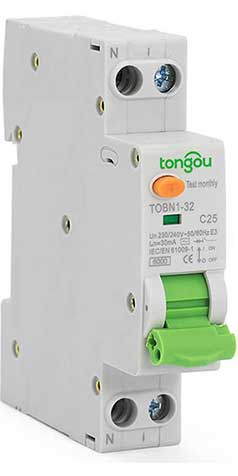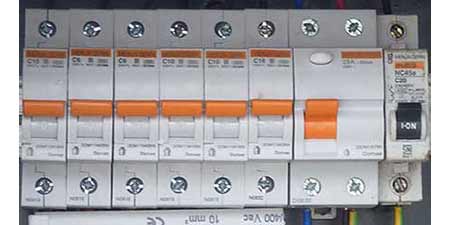Residual Current Electrical Safety Devices
Residual Current and Earth Leakage Circuit Breakers
Residual current contact breakers, formerly known as earth leakage detectors, are used to protect people from electrocution by electrical circuits.
Here we will look at fuses, miniature contact breakers (MCB), earth leakage contact breakers (ELCB), residual current devices (RCB) and Residual Current Contact Breakers with Overload Protection (RCBO).
We will look at what they are, how they work and how they should be installed.

Electrons rush to earth
Electricity is made up of electrons and electrons will always try and find their way back to earth.
If we have a fault such as a short circuit in our electrical circuits they will escape and rush headlong to earth. So vigorous are they in their endeavour they will produce heat that may result in your house burning down or, if you just happen to get in their way, a well kicked bucket.
We need to protect ourselves against the dangers of earth bound electrons.
Fuses
The first electrical protection devices were fuses. As we all know the concept is simple, somewhere on ots way into an electrical system the live wire is passed through a fuse which has a short length of soft, easily melted metal wire. If the electric current becomes too high the wire gets hot and melts and the electrical current is cut off.
The first fuses were being used as early as 1864 to protect telegraph systems from lightning strikes.
Note that It is excessive current rather than voltage that produces heat and melts the wire and it is also current rather than voltage that kills us if we are electrocuted.
Miniature Circuit Breakers known as MCBs
Fuses were replaced in the 1960s by miniature circuit breakers or MCBs which are still in general use in many countries to this day.
Unfortunately, just like fuses before them, MCBs have a fundamental problem - there is a distinct tendency for people to pass onto another realm leaving behind a carcass fried to a deep shade of charcoal long before the MCB trips out
It was clear that a better system was needed.
Earth Leakage Contact Breakers or ELCB
In order to protect people and animals from injury or death the Earth Leakage Contact Breaker or ELCB was developed. These devices work by detecting electricity that has leaked from the live and neutral wires to the earth connections in electrical circuits.
These earlier ELCBs became widely available around 60 years ago and they worked by detecting differences in voltage.
However anyone who, in the school physics laboratory, played with shock machines or generators that sent blue flashes to your nose knows that you can have high voltages without large currents and it is in fact current (the flow of electricity) that kills you and not voltage.
Development of the Residual Current Device or RCD
So around 40 years ago a new type of ELCB became available which worked, not on voltage but in current. By checking the current flow going into a circuit with the current flow coming out (these should be the same) they can detect if there is a problem. These were found to be more reliable and provided a higher level of safety. Unfortunately both devices were known as ELCBs and this caused a worrying confusion and so, in their wisdom, the international electrical standards body or IEC officially renamed these new current detecting switches Residual Current Devices or RCDs or RCCBs
Residual Current Circuit Breaker (RCCB)
The Residual Current Circuit Breaker can detect problems and switch the power off.
How do they work?
In an electrical circuit the power going into the circuits through the live wire should always be the same as the power returning through the neutral wire because it is travelling around a closed circuit. If there is a fault in the circuit and power is leaking away to earth somewhere then the power passing into the circuit through the live connection will not be the same as the power passing out of the circuit through the neutral wire. This difference is known as residual current. We place a small coil of wire around the live and neutral wires inside the switch which can detect if the power is different, it then uses this power difference or residual current to switch the power off.
These devices are very sensitive and work very quickly. Electrical standards demand that they operate from a current of 30 milliamps and switch the power off faster than it takes a flea to burp, far quicker than the shock could harm us.
So now we have two devices to protect us:
- The Miniature Circuit Breaker or MCB that cuts the power off if the current gets too high and
- The Residual Current Circuit Breaker or RCCB that cuts the power off if there is a leakage of power indicating a fault. These are two devices perform very different purposes both of which are important.
The vast majority of electrical installations in Indonesia have standard contact breakers (MCBs) installed but do not have residual current devices. Electrocution protection is becoming more common and we now find a few modern private buildings and many new commercial buildings are having RCCBs installed however there is a common problem.
Let us look at an example.

Here we see a typical new installation in a villa. The power comes into a master contact breaker (MCB) on the right (the black switch) - it will cut out at loads more than 20 amps.
Second from the right we see a Residual Current Circuit Breaker (RCCB) which will cut out if there is a fault causing a small residual current. The power then feeds from the RCCB into the 6 circuit breakers (MCBs) on the left.
This arrangement is very common but has a fundamental problem. RCCBs are very sensitive and any slight fault on any one of the 6 circuits will make the RCCB cut out.
Frustrated local electricians, faced with the problem of trying to find a fault that could be on any one of so many circuits, will tend to bypass the RCCB rather than trying to find and fix the problem.
You are not protected and you probably won't even know it.
So how do we get around this and make sure we are protected?
We install an RCBO on each circuit.
Residual Current device with Overload Protection or RCBO
An RCBO combines the two functions, it is a contact breaker (MCB) to provide overload protection with a residual current device (RCD) built into it to provide electrocution protection.
These devices are now mandatory in many western countries. They are known as a GFCIs (Ground Fault Circuit Interrupters) in America and Canada, RCBOs in Europe and as RCDs (Residual Current Device) or safety switches in Australia. Some people may still refer to them as Earth Leakage Detectors however it should be assumed that they really mean residual current devices.
Pictured we see a typical RCBO. Note that lower half is the MCB providing the overload protection while the upper half is the RCD containing the coil that senses current leakage.
- Live power from the electrical supply comes in to the connector L IN at the bottom.
- The blue cable connects to the electrical supply neutral Neutral coming in from the neutral buzz bar (don't know what a buzz bar is? - don't worry about it)
- Live power and neutral power goes out to the house circuits from connectors L OUT and N OUT at the top.
- The thin wire connects to the earth, this will make sure there is power to switch the unit off if there is a break somewhere.
There is, of course, just like any circuit breaker, a manual switch. Up is on and down, as shown, is off. If there is a fault or an overload on the electrical circuit this switch should turn off.
You will also note a button above the switch. This is a test button to make sure the unit is working correctly. If you press this button the main switch should switch off.
Installation
Beware, many people won't even know what an RCBO is. You will need to find an electrican who understand about RCBOs and how they work to install them for you. You may also have to order them as most electrical shops won't have them in stock.
Most buildings have a number of different circuits for power, lighting, air conditioning, pumps, etc. To be safe an RCBO should be installed instead of an MCB on each electrical circuit.
RCBOs are more expensive than MCBs but - how much is a life worth?
Phil Wilson
Copyright © Phil Wilson October 2016
This article, or any part of it, cannot be copied or reproduced without permission from the copyright owner.
